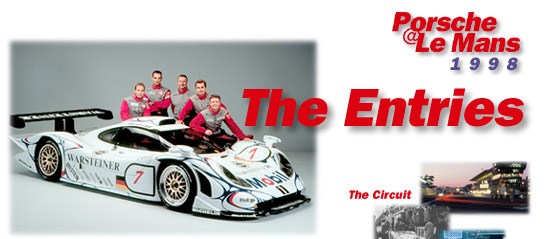


 With the introduction of a new 911 Carrera production model and a new 911 Grand Turismo model, 1998 is proving to be a revolutionary year indeed for the 911 concept. Not surprisingly, the third generation of Porsche's original 1996 GT racecar is replete with innovations. Project leader Norbert Singer replaced the standard front section on last year's 911 GT1 Evo model with a carbon fiber monocoque that delivers enhanced rigidity, improved suspension and better aerodynamics. The use of advanced materials, coupled with modifications like a lighter battery and alternator, shaved the 911 GT1's overall weight to 950 kg (2090 Lbs.), a savings of 100 kg (220 Lbs.) over its predecessor.
With the introduction of a new 911 Carrera production model and a new 911 Grand Turismo model, 1998 is proving to be a revolutionary year indeed for the 911 concept. Not surprisingly, the third generation of Porsche's original 1996 GT racecar is replete with innovations. Project leader Norbert Singer replaced the standard front section on last year's 911 GT1 Evo model with a carbon fiber monocoque that delivers enhanced rigidity, improved suspension and better aerodynamics. The use of advanced materials, coupled with modifications like a lighter battery and alternator, shaved the 911 GT1's overall weight to 950 kg (2090 Lbs.), a savings of 100 kg (220 Lbs.) over its predecessor.
To shape the carbon fiber body and undercarriage for optimal aerodynamics, designers and engineers in the racing department spent many weeks and weekends in the two Porsche wind tunnels at Weissach. The result is a fluid shaped with improved distribution of downforce for the 4.89m long (+20cm), 1.99m wide (+5cm), and 1.14m high (-3cm) vehicle. The 100-liter safety tank now lies between the rear wall of the cockpit and the engine.
The water-cooled engine features 3.162ccm displacement, four valves per cylinder and an aluminum engine block and cylinder head. The two KKK turbo-chargers, limited by 33.9 mm restrictors, deliver ca 550 hp at 7200 revs. Maximum torque is 630 Nm at 5000 rpm. Power is delivered to the rear axle via a six-speed sequential gearbox.
The wheel base of the double wishbone suspension was lengthened to 270 cm. The braking system consists of four massive carbon fiber discs with a 380 mm diameter, eight-piston fixed calipers in the front and six-piston fixed calipers in back.
911 GT1/911 GT1 Evo (1996/97)
The 911 GT1's first roll-out, and the initial step of Porsche's return to the highest levels of international motorsport, took place on March 14,1996 in Weissach. While the front section and crucial components were standard, this 911 GT1 was the first mid-engine 911. Its debut in Le Mans 1996 reaped a double-class victory, second and third overall. Three outright wins in the BPR GT series and many fine results in the FIA GT 1997 Championship followed. Porsche also competed in the first races of the 1997 season with the 1996 model.
Le Mans 1997 and at the following FIA GT round on the Nürburgring marked the premier of the Porsche 911 GT1 Evo. Apart from extensive detail work, the suspension and aerodynamics were also significantly improved. The 911 GT1 featured a sequential six-speed gearbox developed and built at Porsche. Air restrictors of 35.7mm limited the 3.2-liter boxer engine's output to approximately 600 hp at 7200 rpm
1998 Porsche 911 GT1
Technical Specifications
Engine: 6 cylinder Boxer mid-engine, 3162 ccm, stroke 74.4 mm, bore 95 mm, 365 kW (550 bhp) at 7200 rpm, 630 Nm at 5500 rpm, aluminum block/heads, water-cooled, 4 valves per cylinder, 2 KKK turbo chargers with restrictor, 2 intercoolers, TAG electronic engine management
Transmission: 6-speed sequential gearbox, rear wheel drive
Suspension: Double wishbones front & rear with pushrods, adjustable shock absorbers, coils, anti-roll bar all-round, 1-part BBS racing rims centrally mounted, power steering, 380 mm Ĝ, disc brakes
Body: Carbon fiber monocoque and bodywork with air inlet to turbo chargers on the roof, plastic rear wing, plastic side windows
Weight: 950 kg (2090 Lbs.)

